Table of Contents
A well-proportioned floor covering transforms a room from disjointed to harmonious. The right dimensions anchor furniture, define zones, and elevate your decor effortlessly. Too small, and the space feels unfinished. Too large, and it overwhelms.
Consider traffic flow, furniture placement, and material durability. Patterns and layering techniques create visual depth, while painter’s tape helps visualize proportions before buying.
This guide breaks down room-specific solutions for living areas, dining spaces, and bedrooms. Avoid common pitfalls and discover measurement tricks for a polished look.
Why Rug Size Matters
Size matters more than you think when it comes to defining your room’s vibe. A poorly sized floor covering can make even the most stylish furniture feel awkward or disconnected. It’s the Goldilocks principle—too big or too small, and the magic disappears.
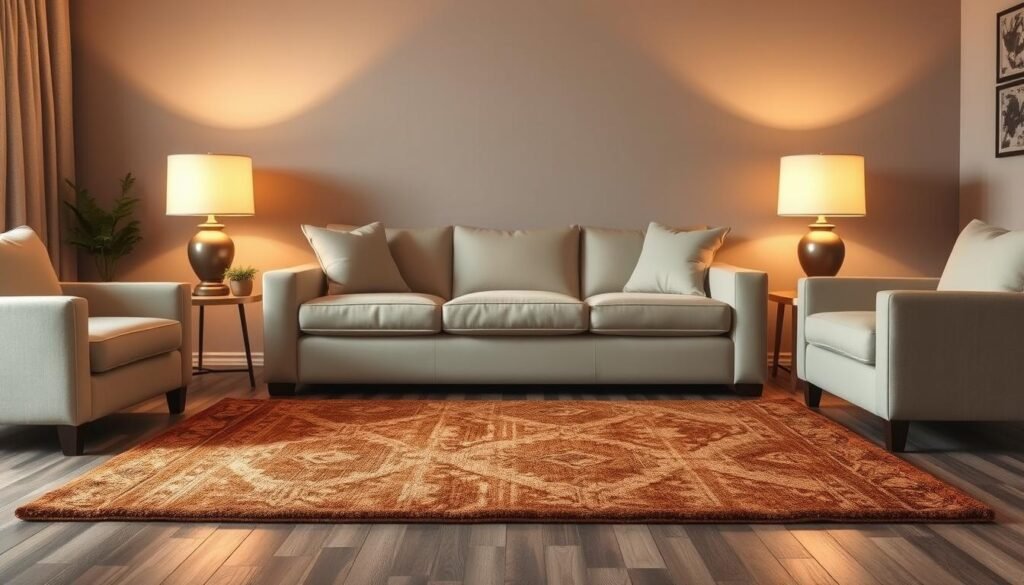
Too-small rugs fracture your space visually. Sofas and chairs appear to “float,” creating a cluttered look. *Designers call this the ‘floating furniture’ effect.* Worse, undersized options become tripping hazards at edges.
On the flip side, oversized rugs swallow the room. They leave no breathing room for hardwood or tile, making the area feel cramped. One designer recalls a client’s *living room* that felt “like walking on a carpeted gym” after a 10’x14’ *area rug* overwhelmed it.
Proportions impact function too. Standard clearance (18–24 inches from walls) ensures smooth traffic flow. A balanced *room* divides zones naturally—like a 5’x8’ rug defining a reading nook.
Studies show humans perceive symmetrical spaces as 15% more inviting. That’s why a well-sized foundation feels instinctively right. And remember: buying wrong costs you. Returns or replacements add 20–30% to your budget.
General Rules for Choosing Rug Sizes
The secret to a balanced room lies in mastering a few simple sizing principles. Whether you’re styling a cozy studio or a sprawling living area, these guidelines ensure your area rugs enhance—not overwhelm—your space.
The 2-Foot Extension Rule
For dining areas, measure 24 inches beyond the table’s edges. This gives chairs enough room to slide out without catching the rug size. No more awkward half-on, half-off wobbles!
In living rooms, apply a similar logic: sofas and chairs should either fully sit on the rug or at least have their front legs anchored. This creates a unified look.
Furniture Placement Guidelines
Anchor key pieces like sofas and beds with at least their front legs on the rug. For heavier furniture, ensure the rug’s material can handle the weight. Jute or sisal may dent over time.
In studios, bend the rules slightly. A 5’x8’ rug under a coffee table can define a seating area without crowding the floor.
Leaving Bare Floor Space
Keep 8–10 inches of exposed floor around the rug’s edges. This “breathing room” makes the space feel intentional. For larger rooms, aim for 18–24 inches.
Pro tip: Use painter’s tape to map out dimensions before buying. It’s a game-changer for odd-shaped rooms.
How to Choose Rug Size for a Living Room
Your living space deserves a foundation that pulls everything together. Start with the right dimensions—too small, and your furniture floats; too big, and the room suffocates.
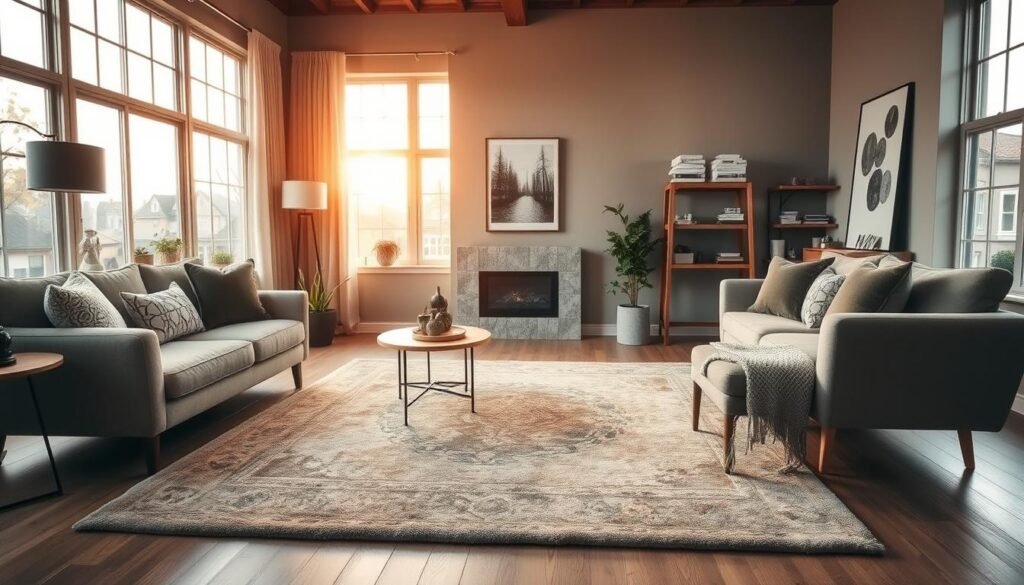
Match Dimensions to Your Space
For rooms under 10’x12’, a 6’x9’ living room rug fits snugly. Medium spaces (12’x15’) shine with 8’x10’ or 9’x12’ options. Larger rooms? Go bold with 10’x14’.
Pro tip: Leave 18–24 inches of bare floor around edges. This frames the space like a picture.
Legs On or Off? It Depends
Sectionals look best with all legs on the rug. For loveseats, anchor just the front feet. This creates cohesion without overcrowding.
Open-concept homes benefit from layered rugs. Try a neutral jute base with a smaller patterned area rug on top.
Layering Like a Designer
The *rug sandwich* technique adds depth: place a sisal rug under a plush wool one. Use non-slip pads to prevent shifting.
Celebrity hack: Nate Berkus layers vintage kilims over seagrass for texture. Follow the *60-30-10* color rule for balance.
Dining Room Rug Sizing Guide
The perfect dining experience starts from the ground up—literally. A well-proportioned foundation ensures chairs glide smoothly, spills stay manageable, and the space feels intentional. Follow these rules to avoid the dreaded “wobbly chair” effect.
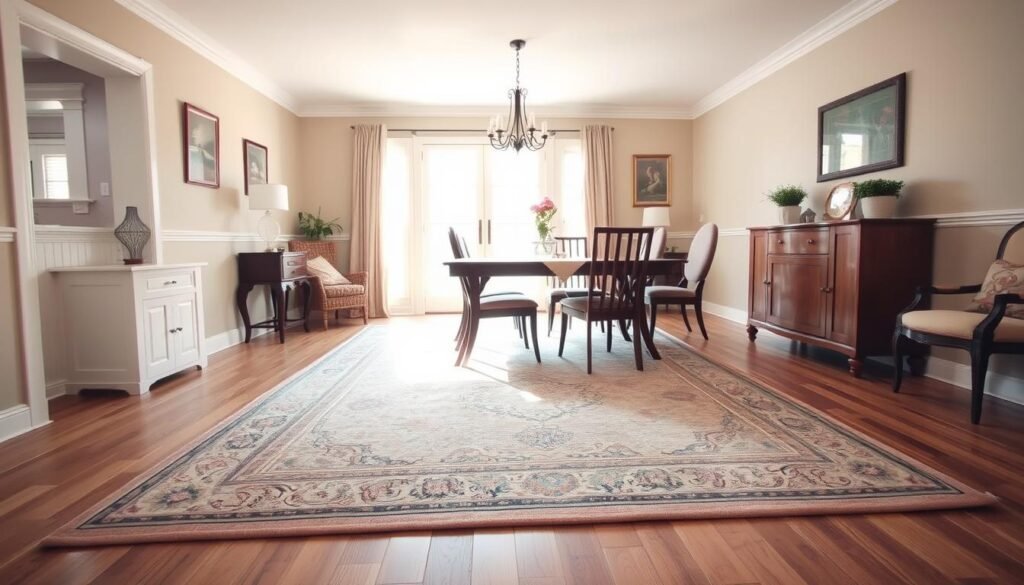
Measuring for Table and Chairs
Always add 24 inches to your table’s dimensions. This gives chairs room to slide out without tipping. For a 6-foot table, aim for an 8’x10’ rug sizes option.
Test different layouts with painter’s tape. Formal dining room setups need symmetry, while casual areas can skew boho with layered rugs.
Round vs. Rectangular Dining Rugs
Round tables shine with circular rugs—just match the diameter plus 24 inches. Rectangular options suit long farmhouse tables but avoid overwhelming small spaces.
Pro tip: For leaf extensions, choose a rug that fits the expanded table. Stain-resistant polypropylene handles messy dinners best.
“A rug should frame the meal, not compete with it.”
- Formal dining: Persian or wool rugs with 18″ wall clearance
- Casual meals: Washable cotton or jute, tighter to walls
- Restaurant trick: Darker hues hide crumbs between cleanings
Bedroom Rug Placement Tips
Step onto comfort every morning with perfectly placed floor coverings. The right dimensions soften steps, define sleep zones, and tie your decor together. Avoid tripping hazards and chilly toes with these pro strategies.
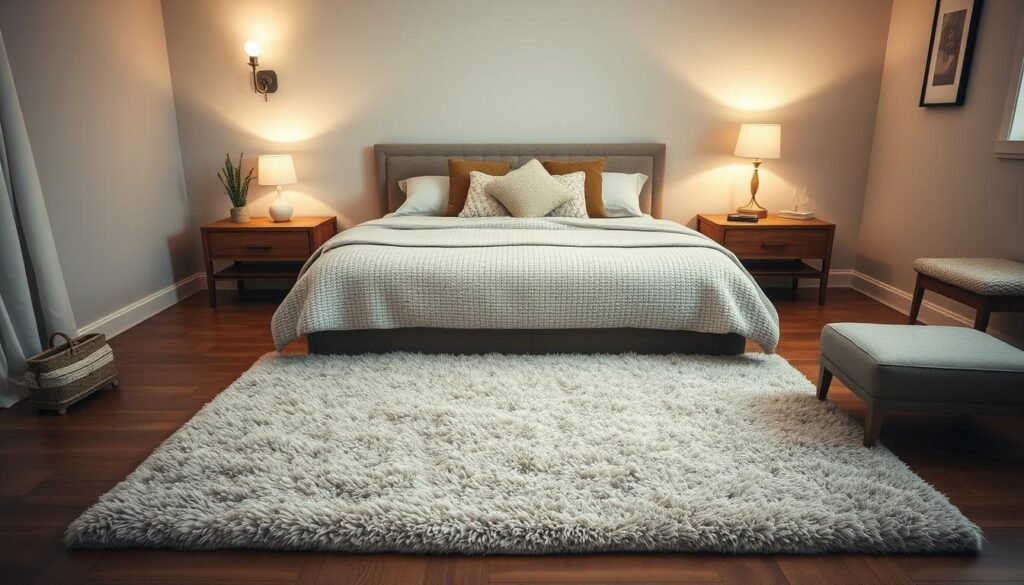
Queen and King Bed Proportions
For a queen bed, a 6’x9’ rug fits neatly under the lower two-thirds. Extend it 2 feet beyond the sides for balanced coverage. King beds need 8’x10’ options to frame the space.
Luxury hotel secret: Center the rug under the bed for symmetry. Leave equal bare floor space on three sides—like a picture frame.
Runners for Cozy Landings
Flank the bed with runners for plush morning landings. Choose low-pile materials like flatweave wool for easy vacuuming. Rugs with non-slip backing prevent shifts during nighttime moves.
- Temperature control: Thick-pile options insulate against cold floors.
- Washable picks: Machine-washable cotton by the bedside hides spills.
- Feng Shui tip: Place runners horizontally to “guide” energy flow.
“A bedroom rug should whisper comfort, not shout for attention.”
Layer a small patterned area rug over jute for texture. This trick adds depth without overwhelming the space. Test layouts with painter’s tape before committing.
Rug Sizes for High-Traffic Areas
High-traffic zones demand rugs that can handle daily wear while still looking sharp. These areas—entryways, hallways, kitchens—need materials tough enough for spills, shoes, and constant traffic. Balance durability with style to keep your home functional and inviting.
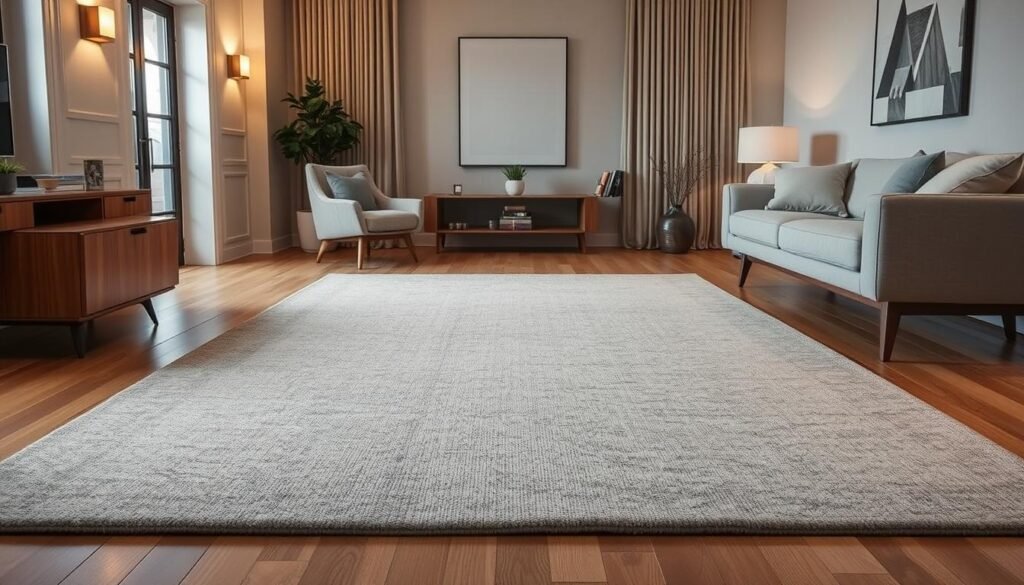
Entryways and Hallways
Entryway rugs should extend 6 inches beyond the door swing. For narrow halls, leave 8–12 inches of bare floor on each side. Low-pile polypropylene resists dirt and dries fast.
- Commercial-grade options outperform residential in heavy-use spaces.
- Pet-friendly: Flatweave wool hides scratches; avoid long fibers that trap hair.
- ADA tip: Keep pile height under ½ inch for wheelchair accessibility.
Kitchen and Mudroom Solutions
Place anti-fatigue mats near sinks and stoves—they cushion feet during long prep sessions. In mudrooms, pair boot trays with machine-washable runners for easy cleanup.
“Layer rugs over vinyl flooring for warmth, but secure them with non-slip pads to prevent trips.”
- Seasonal swaps: Jute in summer, plush wool in winter.
- Industrial inspo: Restaurant-grade rubber mats handle grease and spills.
- Grip pads: Double-sided tape keeps rugs in place during heavy traffic.
Outdoor Rug Sizing
Outdoor spaces thrive when anchored by the right foundation—start with dimensions that enhance, not overpower. Unlike indoor areas, these zones battle sun, rain, and wind. A well-sized outdoor rug resists fading, drains quickly, and ties furniture together.
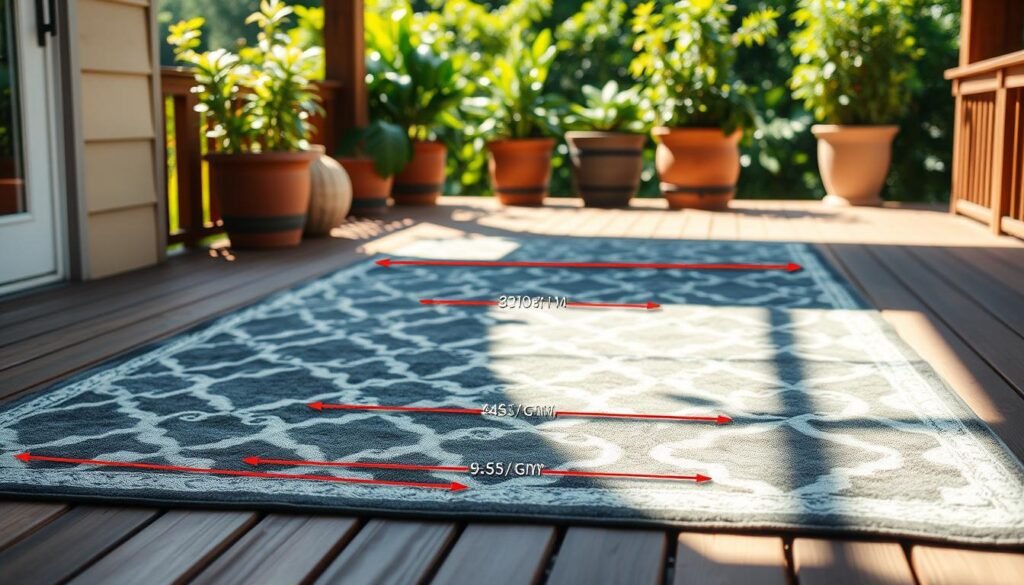
Patio and Deck Considerations
Extend 2 feet beyond furniture on all sides. A 5’x8’ rug fits bistro sets, while 8’x10’ frames sectional sofas. *Pro tip:* Leave 6 inches of decking exposed for drainage.
- UV resistance: Polypropylene lasts 5x longer than cotton in direct sun.
- Drainage: Perforated rugs prevent puddles; avoid rubber backs in humid climates.
- Anchoring: Sandbag corners or use spiral stakes for windy spots.
Conversation Set Coverage
Match table shapes: Rectangular rugs suit long dining sets, while round ones echo fire pits. Ensure all chairs stay on the rug when pulled out.
| Area | Material | Key Feature |
|---|---|---|
| Balcony | Recycled plastic | Lightweight, folds for storage |
| Poolside | Quick-dry polyester | Non-slip, chlorine-resistant |
| Fire pit | Wool blend | Flame-retardant, 36″ clearance |
“Layer outdoor rugs over gravel or turf for texture—just secure with landscape spikes.”
For coastal homes, rinse salt spray weekly. Mountain cabins? Opt for darker hues to hide dirt. Store rolled up with breathable fabric covers during winter.
Choosing Rug Materials for Your Space
The right material underfoot can make or break your room’s comfort and style. Fibers affect everything from durability to allergen resistance. Whether you prioritize plushness or practicality, your choice sets the tone for daily living.
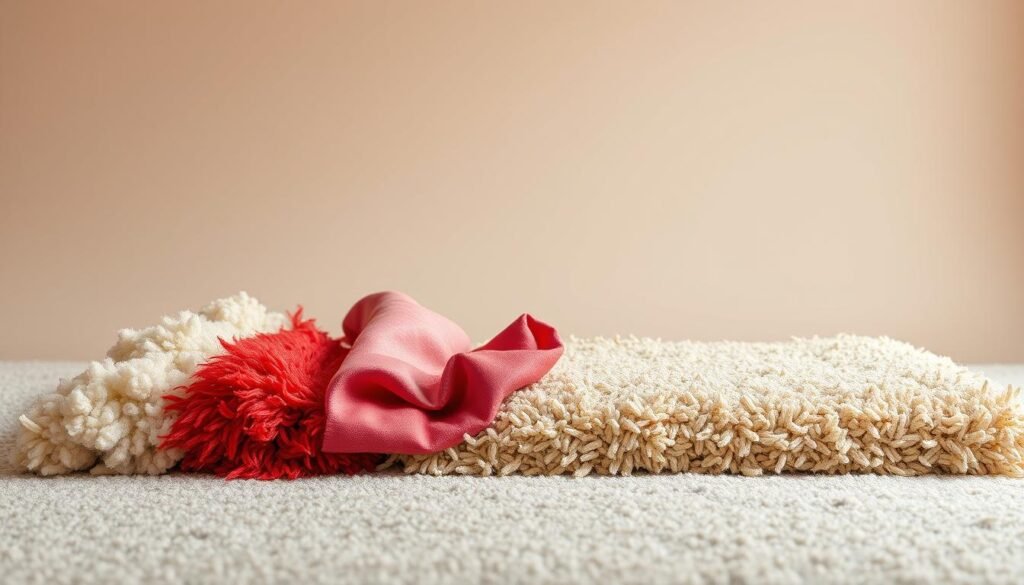
Natural vs. Synthetic Fibers
Wool reigns supreme for warmth and sound absorption, but it’s pricey. Nylon rivals it for stain resistance—perfect for homes with kids or pets. Here’s a quick breakdown:
| Material | Best For | Lifespan |
|---|---|---|
| Wool | Bedrooms, low-traffic areas | 15+ years |
| Nylon | Hallways, entryways | 10–12 years |
| Jute | Eco-friendly spaces | 5–7 years |
| Polypropylene | Outdoor/damp areas | 8–10 years |
Allergy sufferers should avoid wool—it traps dust mites. Synthetic fibers like polyester resist mold and mildew, a win for humid climates.
Best Pile Heights for Different Rooms
Low-pile (under ½ inch) works best in high-traffic zones. It’s easy to vacuum and won’t trip guests. Plush rugs (over 1 inch) add luxury to bedrooms but snag pet claws.
- Vacuum compatibility: Flatweaves glide smoothly; shag requires suction adjustments.
- Fire resistance: Wool self-extinguishes; synthetics need chemical treatments.
- Artisan markers: Hand-knotted rugs show slight irregularities—proof of craftsmanship.
“Layer a low-pile rug over a PVC pad for extra cushion—your foot will thank you after long days.”
For sustainability, look for OEKO-TEX® certifications. Historic weaving techniques, like Persian knots, add value but cost more. Always request material samples—colors vary online.